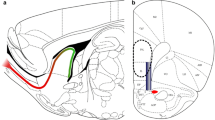Summary
We observed the histological peculiarities of the repair process in a destructive lesion of the developing rat brain during neurogenesis.
Degeneration was induced selectively in certain cells of the proliferating phase in the rat fetal neopallium on embryonic day 16 by transplacental administration of ethylnitrosourea. Successive elimination of necrotic cells and the restoration process were observed.
The repair process was divided into the following steps.
-
1)
Elimination of individually affected cells by phagocytes in the pre-existing extracellular space.
-
2)
Successive restoration of the disintegrated area by cells wh ich differentiated from remaining matrix cells.
No reactive gliosis, fibrosis, abnormal vascularization or infiltration of granulocytes and lymphocytes was observed at any time. The thinned neopallium on postnatal day 21 revealed only a small number and abnormal distribution of the cortical neurons.
It may be assumed that the fetal brain owes its unique repair features to the presence of a vast extracellular space under normal conditions. In this pre-existing extracellular space, every kind of cell seems to exist separately without the intercellular adhesions characteristic of the adult brain. When degeneration occurs in certain cells the phagocytes would be able to eliminate the degenerate cells completely in this space without having to break intercellular adhesions. As a result, after the completion of cell elimination, the injured brain is restored to its original state with no cell reaction, giving the appearance of a small brain with normal-looking histological architecture, save only for the sparseness of cells.
Similar content being viewed by others
References
Berry M, Rogers AW, Eayrs JT (1964) The pattern and mechanism of migration of the neuroblasts of the developing cerebral cortex. J Anat 98:291–292
Bignami A, Dahl D (1974) Astrocyte-specific protein and neuroglial differentiation. An immunofluorescence study with antibodies to the glial fibrillary acidic protein. J Comp Neurol 153:27–37
Bignami A, Raju T, Dahl D (1982) Localization of vimentin, the nonspecific intermediate filament protein, in embryonal glia and in early differentiating neurons. Develop Biol 91:286–295
Bosch DA (1977) Short and long term effects of methyl- and ethylnitrosourea (MNU & ENU) on the developing nervous system of the rat. II: Short term effects; Concluding remarks on chemical neuro-oncogenesis. Acta Neurol Scandinav 55:106–122
Boulder Committee (1970) Embryonic vertebrate central nervous system: Revised terminology. Anat Rec 166:257–262
Friede RL (1975) Developmental neuropathology. Springer, Wien, pp 10–105
Fujita S (1962) Kinetics of cellular proliferation. Exp Cell Res 28:52–60
Fujita S (1963) The matrix cell and cytogenesis in the developing central nervous system. J Comp Neurol 120:37–42
Fujita S (1966) Applications of light and electron microscopic autoradiography to the study of cytogenesis of the forebrain. In: Hassler R, Stephan H (eds) Evolution of the forebrain: Phyogenesis and ontogensis of the forebrain. Georg Thieme Verlag, Stuttgart, pp 180–196
Fujiwara H (1980) Cytotoxic effects of ethylnitrosourea on central nervous system of rat embryos: Special references to carcinogenesis and teratogenesis. Acta Pathol Jpn 30:375–387
Goldberg B, Rabinovitch M (1983) Macrophages. In: Weiss L (ed) Histology: Cell and tissue biology. 5th ed. The Macmillan press, London and Basingstoke, pp 160–170
Ikuta F, Yoshida Y, Ohama E, Oyanagi K, Takeda S, Yamazaki K, Watabe K (1983) Revised pathophysiology on BBB damage: The edema as an ingeniously provided condition for cell motility and lesion repair. Acta Neuropathol (Berl) Suppl VIII:103–110
Ikuta F, Yoshida Y, Ohama E, Oyanagi K, Takeda S, Yamazaki K, Watabe K (1984) Brain and peripheral nerve edema as an initial stage of the lesion repair: Revival of the mechanisms of the normal development of the fetal brain. Shinkeikenkyu no shimpo 28:599–628
Imamoto K, Leblond CP (1977) Presence of labeled monocytes, macrophages and microglia in a stab wound of the brain following an injection of bone marrow cells labeled with3H-uridine into rats. J Comp Neurol 174:255–280
Kleihues P (1969) Blockeirung der DNA Synthesise durch N-Methyl-N-Nitrosoharnstoff in vivo. Arzneim Forsch 19:1041–1043
Larroche J-C (1984) Malformations of the nervous system. In: Adams JH, Corsellis JAN, Duchen LW (eds) Greenfield's neuropathology. 4th ed. Edward Arnold, London, p 385
Levitt P, Cooper ML, Rakic P (1981) Coexistence of neuronal and glial precusor cells in the cerebral ventricular zone of the fetal monkey: An ultrastructural immunoperoxidase analysis. J Neurosci 1:27–39
Levitt P, Cooper ML, Rakic P (1983) Early divergence and changing proportions of neuronal and glial precursor cells in the primate cerebral ventricular zone. Dev Biol 96:472–484
Matsumoto Y, Ikuta F (1985) Appearance and distribution of fetal brain macrophages in mice: Immunohistochemical study with a monoclonal antibody. Cell Tissue Res 239:271–278
Miquel J, Foncin J-F, Gruner JE, Lee JC (1982) Cerebral edema. In: Haymaker W, Adams RD (eds) Histology and histopathology of the nervous system. Charles C Thomas, Springfield, pp 871–919
Nakanishi S (1983) Extracellular matrix during laminar pattern formation of neocortex in normal and reeler mutant mice. Dev Biol 95:305–316
Sidman RL, Rakic P (1973) Neuronal migration, with special reference to developing human brain: A review. Brain Res 62:1–35
Spatz H (1921) Über die Vorgänge nach experimenteller Rückenmarksdurchtrennung mit besonderer Berücksichtigung der Unterschiede der Reaktionsweise des reifen und des unreifen Gewebes nebst Beziehungen zur menschlichen Pathologie (Porencephalie und Syringomyelie). Nissl-Alzheimer Histolog Histopatholog Arb EB:49–364
Sumi SM, Hager H (1968) Electron microscopic study of the reaction of the newborn rat brain to injury. Acta Neuropathol (Berl) 10:324–335
Sumi SM (1969) The extracellular space in the developing rat brain: Its variation with changes in osmolarity of the fixative, method of fixation and maturation. J Ultrastruct Res 29:398–425
Yoshida Y, Oyanagi K, Ikuta F (1984) Initial cellular damage in the developing rat brain caused by cytotoxicity of ethylnitrosourea. Brain Nerve 36:175–182
Author information
Authors and Affiliations
Additional information
This study was supported by a Grant-in-Aid for Scientific Research (A) 57440050, 60015024 and 60440046 from the Ministry of Education, Science and Culture, Japan
Rights and permissions
About this article
Cite this article
Oyanagi, K., Yoshida, Y. & Ikuta, F. The chronology of lesion repair in the developing rat brain: Biological significance of the pre-existing extracellular space. Vichows Archiv A Pathol Anat 408, 347–359 (1986). https://doi.org/10.1007/BF00707693
Accepted:
Issue Date:
DOI: https://doi.org/10.1007/BF00707693



